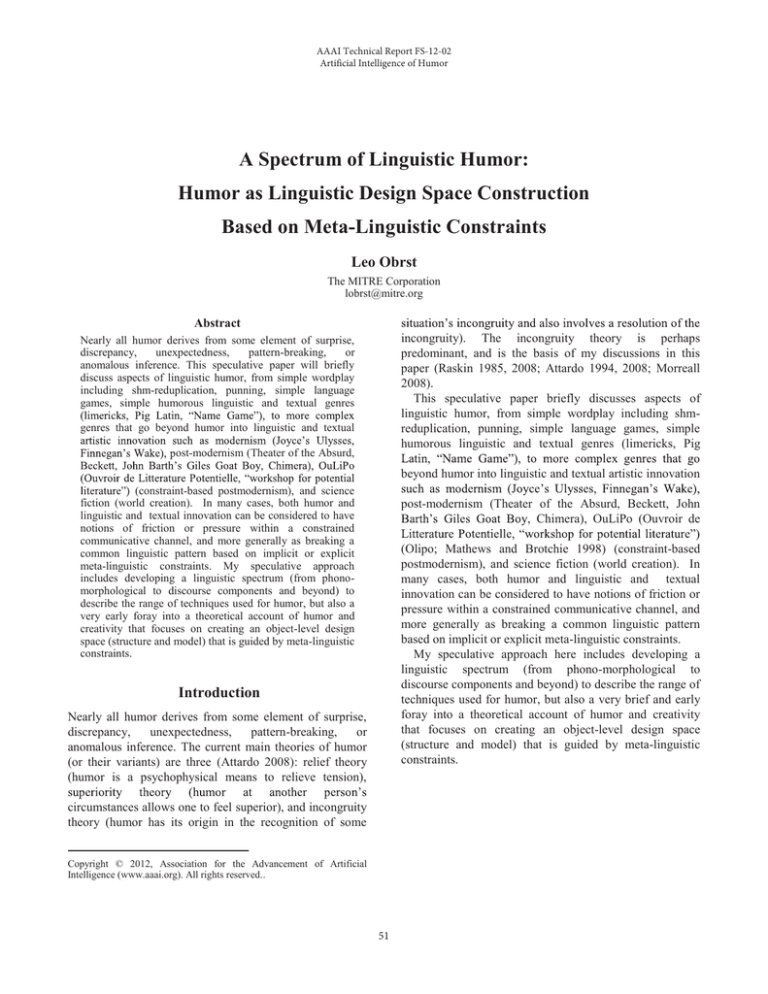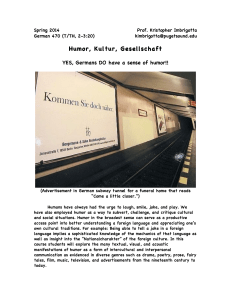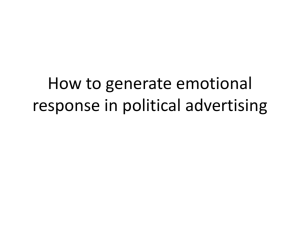
AAAI Technical Report FS-12-02
Artificial Intelligence of Humor
A Spectrum of Linguistic Humor:
Humor as Linguistic Design Space Construction
Based on Meta-Linguistic Constraints
Leo Obrst
The MITRE Corporation
lobrst@mitre.org
Abstract
incongruity). The incongruity theory is perhaps
predominant, and is the basis of my discussions in this
paper (Raskin 1985, 2008; Attardo 1994, 2008; Morreall
2008).
This speculative paper briefly discusses aspects of
linguistic humor, from simple wordplay including shmreduplication, punning, simple language games, simple
humorous linguistic and textual genres (limericks, Pig
Nearly all humor derives from some element of surprise,
discrepancy,
unexpectedness,
pattern-breaking,
or
anomalous inference. This speculative paper will briefly
discuss aspects of linguistic humor, from simple wordplay
including shm-reduplication, punning, simple language
games, simple humorous linguistic and textual genres
genres that go beyond humor into linguistic and textual
ost-modernism (Theater of the Absurd,
beyond humor into linguistic and textual artistic innovation
(constraint-based postmodernism), and science
fiction (world creation). In many cases, both humor and
linguistic and textual innovation can be considered to have
notions of friction or pressure within a constrained
communicative channel, and more generally as breaking a
common linguistic pattern based on implicit or explicit
meta-linguistic constraints. My speculative approach
includes developing a linguistic spectrum (from phonomorphological to discourse components and beyond) to
describe the range of techniques used for humor, but also a
very early foray into a theoretical account of humor and
creativity that focuses on creating an object-level design
space (structure and model) that is guided by meta-linguistic
constraints.
post-modernism (Theater of the Absurd, Beckett, John
, Chimera), OuLiPo (Ouvroir de
(Olipo; Mathews and Brotchie 1998) (constraint-based
postmodernism), and science fiction (world creation). In
many cases, both humor and linguistic and textual
innovation can be considered to have notions of friction or
pressure within a constrained communicative channel, and
more generally as breaking a common linguistic pattern
based on implicit or explicit meta-linguistic constraints.
My speculative approach here includes developing a
linguistic spectrum (from phono-morphological to
discourse components and beyond) to describe the range of
techniques used for humor, but also a very brief and early
foray into a theoretical account of humor and creativity
that focuses on creating an object-level design space
(structure and model) that is guided by meta-linguistic
constraints.
Introduction
Nearly all humor derives from some element of surprise,
discrepancy,
unexpectedness,
pattern-breaking,
or
anomalous inference. The current main theories of humor
(or their variants) are three (Attardo 2008): relief theory
(humor is a psychophysical means to relieve tension),
circumstances allows one to feel superior), and incongruity
theory (humor has its origin in the recognition of some
Copyright © 2012, Association for the Advancement of Artificial
Intelligence (www.aaai.org). All rights reserved..
51
which gets resolved to (the important point is that the
This may not even be a
completely new point, as previous humor theorists may
The Components of Linguistic Humor
Linguistic humor uses components of the strata or levels
typically posited by linguistic theory: phonology (and
phonetics), morphology, syntax, semantics, and
pragmatics. In addition, the constructs used in linguistic
humor range from words (or parts of words) to sentences
or utterances, to extended discourses. In addition, various
genres of discourses (texts) constitute linguistic humor:
puns, narrative jokes (with many sub-genres), poetry (e.g.,
limericks), word games or extended schemes (shmreduplication, Pig Latin, rhyming games such as the Name
Game, etc.), extended comedic or humorous discourses
embedded in dramas, narratives, etc. Furthermore, in the
case of more serious fiction, I would argue that some of the
same mechanisms employed in humor are employed in
structural point, but which research I am not aware of. This
does mean that there could be multiple misinterpretations,
i.e., at different structural points: e.g., a pun or puns at the
could establish coherence at a higher level in the
discourse, much like a so-called motif (Motif 2012). Except
of course, here the motif is a misinterpretation motif.
way to create a very elaborate misinterpretation structure
up many levels and across many dimensions.
And so, I arrive at the generalization of this approach (or
set of techniques, since the theory is still very young and
needs to be fleshed out), which is to generalize it to
narrative and poetic forms and genres larger than humor,
but which might also incorporate humorous sub-parts.
Wake), post-modernist (Theater of the Absurd plays such
as Beckett Waiting for Godot, meta-fiction such as John
Giles Goat Boat, and Chimera), and even worldchanging genres such as science fiction (e.g., Frank
Dune
Foundation series)
Lord of the Rings
Wheel of Time series).
I am not proposing an entirely new approach here, but
assuming the basic tenets of the Semantic Script Theory of
Humor (Raskin, 1985), especially as generalized by
General Theory of Verbal Humor
(Attardo 1994, 2008, etc.), which I will not go into in this
short paper. Instead, I suggest a spectrum such as in Figure
1.
Meta-Linguistic Constraint-based Design
This section describes my conjectures about the meta-level,
i.e., the meta-linguistic and meta-ontological levels, where,
I conjecture, humor and in fact other creative efforts, are
designed and then generated as object-level artifacts.
The main point of my approach is that the humorgenerator (provider) is working at a meta-linguistic level
when he/she creates the humorous item, knows that at least
at one level in the spectrum a misinterpretation exists, and
given common knowledge of humans and their semantic
interpretation capabilities, that the humor audience
(consumer) will probably recognize the misinterpretation,
understand the proposed resolution of the incongruity, and
laugh. As with all things human, of course, there may be
degrees of humor expertise on both the generation and
Object-Level Design Space for Humor
This section describes my conjectures about the objectlevel design space for generating and understanding humor
that is guided by meta-linguistic constraints, i.e., possible
world navigation.
What the spectrum in Figure 1, and its way-stations on
both sides (the linguistic
ontology
meta-ontology
range, and the structural range from word
world), is
meant to graphically depict is my view that humor under
the incongruity theory is the result of misinterpretation at a
linguistic
structural level focused on (sound or word or syntactic
attachment, sentence, discourse, etc.) is given an
incongruous generation (by the humor provider) which is
then possibly understood (by the humor consumer) as
permitting anomalous interpretations, one or more of
aberrant world fiction may not find an expected response.
Figure 1. Linguistic Humor Structural Spectrum
52
accommodating my aberrant but strong interest in this
topic.
Conclusion
My conclusion is a bit peremptory, unfortunately, but I
hope that discussion will clarify and refine many of these
issues, and in fact, push this approach forward. Although
time and space constraints truly have precluded
elaboration, I anticipate some future progress along the
lines I have sketched. Here, I am reminded of some quotes
that have guided me:
References
Attardo, Salvatore. 1994. Linguistic Theories of Humor, Walter
de Gruyter.
Attardo, Salvatore. 2008. A Primer for the Linguistics of Humor,
in Raskin, ed., 2008, pp. 101-156.
Bergen, Benjamin, and Binsted, Kim. 2003. The Cognitive
Linguistics of Scalar Humor. Language, Culture, and Mind.
Michel Achard and Suzanne Kemmer (eds.) CSLI Publications.
Coleridge, Samuel Taylor. 1817. Biographia Literaria, ch. 14 p.
314 in Samuel Taylor Coleridge, ed. by H.J. Jackson, Oxford,
1985.
Hempelmann, Christian F. 2008. Computational Humor: Beyond
the Pun. In: Raskin, ed., 2008, pp. 333-359.
Krikmann, Arvo. 2006. Contemporary Linguistic Theories of
Humour. Folklore 33, 2006, pp. 27-58.
Morreall, John. 2008. Philosophy and Religion. In: Raskin, ed.,
2008, pp. 211-242.
Motif. http://en.wikipedia.org/wiki/Motif_%28narrative%29.
Mulder, M.P., and Nijholt, A. 2002. Humour Research: State of
the Art. University of Twente, Center of Telematics and
Information Technology, Technical Report CTIT-02-34,
September 2002, 24 pp.
Nilsen, Don L. F., and Nilsen, Alleen Pace. 2008. Literature and
Humor. In: Raskin, ed., 2008, pp. 243-279.
Partington, Alan Scott. 2009. A Linguistic Account of Wordplay:
The Lexical Grammar of Punning. Journal of Pragmatics.
Volume 41, Issue 9, September 2009, Pages 1794 1809.
Raskin, V. 1985. Semantic Mechanisms of Humor. Dordrecht: D.
Reidel Pub. Co.
Raskin, Victor, ed. 2008. The Primer of Humor Research. Berlin,
New York: Mouton de Gruyter.
Triezenberg, Katrina. 2008. Humor in Literature. In: Raskin, ed.,
2008, pp. 523-542.
Vonnegut, Kurt. 2005. A Man Without a Country: A Memoir Of
Life In George W Bush's America. Seven Stories Press.
In this idea originated the plan of the "Lyrical
Ballads"; in which it was agreed, that my endeavours
should be directed to persons and characters
supernatural, or at least romantic; yet so as to transfer
from our inward nature a human interest and a
semblance of truth sufficient to procure for these
shadows of imagination that willing suspension of
disbelief for the moment, which constitutes poetic
faith. (Coleridge, 1817)
A joke is like building a mousetrap from scratch. You
have to work pretty hard to make the thing snap when
it is supposed to snap. (Vonnegut, 2005)
Werner Heisenberg, Kurt Gödel, and Noam Chomsky
walk into a bar. Heisenberg turns to the other two and
says, "Clearly this is a joke, but how can we figure
out if it's funny or not?" Gödel replies, "We can't
know that because we're inside the joke." Chomsky
says, "Of course it's funny. You're just telling it
wrong."
(http://ask.metafilter.com/72202/Do-youknow-jokes-which-presuppose-obscure-knowledge)
My main conclusion is that humor is the result of an
understood (at the meta-level) ambiguity of semantic
interpretation, but that the interpretation arises at multiple
levels, which indeed can combine to enable more complex
misinterpretations but with directed incongruous
interpretations and resolutions at the object-level that
actually may enable more than humor, i.e., creativity.
How? By actively reacting against the spaces of
misinterpretations that are seen at the meta-level in order to
create humor at the object-level. Or to create possibly more
than humor. Perhaps humor is a vector for us into the
machinery of creativity? Personally, I think so.
Acknowledgments
The views expressed in this paper are those of the authors
alone and do not reflect the official policy or position of
The MITRE Corporation or any other company or
individual. I thank John Sowa for bringing this symposium
to my attention, and thank Victor Raskin for kindly
53




